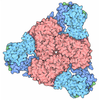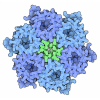[English] 日本語
 Yorodumi
Yorodumi- PDB-9c4e: Structure of endogenous DPYSL2 from rat model of Alzheimer's disease -
+ Open data
Open data
- Basic information
Basic information
| Entry | Database: PDB / ID: 9c4e | ||||||
|---|---|---|---|---|---|---|---|
| Title | Structure of endogenous DPYSL2 from rat model of Alzheimer's disease | ||||||
 Components Components | Dihydropyrimidinase-related protein 2 | ||||||
 Keywords Keywords | NEUROPEPTIDE / Dihydropyrimidinase-related protein 2 | ||||||
| Function / homology |  Function and homology information Function and homology informationCRMPs in Sema3A signaling / hydrolase activity, acting on carbon-nitrogen (but not peptide) bonds, in cyclic amides / Recycling pathway of L1 / olfactory bulb development / positive regulation of glutamate secretion / regulation of neuron differentiation / regulation of axon extension / spinal cord development / synaptic vesicle transport / regulation of neuron projection development ...CRMPs in Sema3A signaling / hydrolase activity, acting on carbon-nitrogen (but not peptide) bonds, in cyclic amides / Recycling pathway of L1 / olfactory bulb development / positive regulation of glutamate secretion / regulation of neuron differentiation / regulation of axon extension / spinal cord development / synaptic vesicle transport / regulation of neuron projection development / regulation of postsynapse assembly / cytoskeleton organization / response to amphetamine / response to cocaine / Schaffer collateral - CA1 synapse / endocytosis / terminal bouton / myelin sheath / presynapse / growth cone / microtubule / cell differentiation / postsynaptic density / response to xenobiotic stimulus / axon / neuronal cell body / dendrite / synapse / protein kinase binding / glutamatergic synapse / protein-containing complex / identical protein binding / membrane / cytosol Similarity search - Function | ||||||
| Biological species |  | ||||||
| Method | ELECTRON MICROSCOPY / single particle reconstruction / cryo EM / Resolution: 2.73 Å | ||||||
 Authors Authors | Khalili Samani, E. / Keszei, A.F.A. / Mazhab-Jafari, M.T. | ||||||
| Funding support |  Canada, 1items Canada, 1items
| ||||||
 Citation Citation |  Journal: Structure / Year: 2025 Journal: Structure / Year: 2025Title: Unveiling the structural proteome of an Alzheimer's disease rat brain model. Authors: Elnaz Khalili Samani / S M Naimul Hasan / Matthew Waas / Alexander F A Keszei / Xiaoxiao Xu / Mahtab Heydari / Mary Elizabeth Hill / JoAnne McLaurin / Thomas Kislinger / Mohammad T Mazhab-Jafari /  Abstract: Studying native protein structures at near-atomic resolution in a crowded environment presents challenges. Consequently, understanding the structural intricacies of proteins within pathologically ...Studying native protein structures at near-atomic resolution in a crowded environment presents challenges. Consequently, understanding the structural intricacies of proteins within pathologically affected tissues often relies on mass spectrometry and proteomic analysis. Here, we utilized cryoelectron microscopy (cryo-EM) and the Build and Retrieve (BaR) method to investigate protein complexes' structural characteristics such as post-translational modification, active site occupancy, and arrested conformational state in Alzheimer's disease (AD) using brain lysate from a rat model (TgF344-AD). Our findings reveal novel insights into the architecture of these complexes, corroborated through mass spectrometry analysis. Interestingly, it has been shown that the dysfunction of these protein complexes extends beyond AD, implicating them in cancer, as well as other neurodegenerative disorders such as Parkinson's disease, Huntington's disease, and schizophrenia. By elucidating these structural details, our work not only enhances our understanding of disease pathology but also suggests new avenues for future approaches in therapeutic intervention. | ||||||
| History |
|
- Structure visualization
Structure visualization
| Structure viewer | Molecule:  Molmil Molmil Jmol/JSmol Jmol/JSmol |
|---|
- Downloads & links
Downloads & links
- Download
Download
| PDBx/mmCIF format |  9c4e.cif.gz 9c4e.cif.gz | 364.9 KB | Display |  PDBx/mmCIF format PDBx/mmCIF format |
|---|---|---|---|---|
| PDB format |  pdb9c4e.ent.gz pdb9c4e.ent.gz | 294.9 KB | Display |  PDB format PDB format |
| PDBx/mmJSON format |  9c4e.json.gz 9c4e.json.gz | Tree view |  PDBx/mmJSON format PDBx/mmJSON format | |
| Others |  Other downloads Other downloads |
-Validation report
| Summary document |  9c4e_validation.pdf.gz 9c4e_validation.pdf.gz | 1.1 MB | Display |  wwPDB validaton report wwPDB validaton report |
|---|---|---|---|---|
| Full document |  9c4e_full_validation.pdf.gz 9c4e_full_validation.pdf.gz | 1.1 MB | Display | |
| Data in XML |  9c4e_validation.xml.gz 9c4e_validation.xml.gz | 55.9 KB | Display | |
| Data in CIF |  9c4e_validation.cif.gz 9c4e_validation.cif.gz | 83.3 KB | Display | |
| Arichive directory |  https://data.pdbj.org/pub/pdb/validation_reports/c4/9c4e https://data.pdbj.org/pub/pdb/validation_reports/c4/9c4e ftp://data.pdbj.org/pub/pdb/validation_reports/c4/9c4e ftp://data.pdbj.org/pub/pdb/validation_reports/c4/9c4e | HTTPS FTP |
-Related structure data
| Related structure data |  45183MC  9c21C  9c28C  9c86C C: citing same article ( M: map data used to model this data |
|---|---|
| Similar structure data | Similarity search - Function & homology  F&H Search F&H Search |
- Links
Links
- Assembly
Assembly
| Deposited unit | 
|
|---|---|
| 1 |
|
- Components
Components
| #1: Protein | Mass: 62349.352 Da / Num. of mol.: 4 / Source method: isolated from a natural source / Source: (natural)  Has protein modification | N | |
|---|
-Experimental details
-Experiment
| Experiment | Method: ELECTRON MICROSCOPY |
|---|---|
| EM experiment | Aggregation state: PARTICLE / 3D reconstruction method: single particle reconstruction |
- Sample preparation
Sample preparation
| Component | Name: Dihydropyrimidinase-related protein 2 / Type: TISSUE / Entity ID: all / Source: NATURAL |
|---|---|
| Source (natural) | Organism:  |
| Buffer solution | pH: 7.4 |
| Specimen | Embedding applied: NO / Shadowing applied: NO / Staining applied: NO / Vitrification applied: YES / Details: Cytosolic fraction of rat brain |
| Specimen support | Grid type: Homemade |
| Vitrification | Instrument: FEI VITROBOT MARK IV / Cryogen name: ETHANE / Humidity: 90 % / Chamber temperature: 278 K |
- Electron microscopy imaging
Electron microscopy imaging
| Experimental equipment |  Model: Titan Krios / Image courtesy: FEI Company |
|---|---|
| Microscopy | Model: FEI TITAN KRIOS |
| Electron gun | Electron source:  FIELD EMISSION GUN / Accelerating voltage: 300 kV / Illumination mode: FLOOD BEAM FIELD EMISSION GUN / Accelerating voltage: 300 kV / Illumination mode: FLOOD BEAM |
| Electron lens | Mode: BRIGHT FIELD / Nominal defocus max: 5000 nm / Nominal defocus min: 500 nm |
| Image recording | Electron dose: 40 e/Å2 / Film or detector model: FEI FALCON IV (4k x 4k) |
- Processing
Processing
| EM software |
| ||||||||||||||||||||||||||||
|---|---|---|---|---|---|---|---|---|---|---|---|---|---|---|---|---|---|---|---|---|---|---|---|---|---|---|---|---|---|
| CTF correction | Type: PHASE FLIPPING AND AMPLITUDE CORRECTION | ||||||||||||||||||||||||||||
| 3D reconstruction | Resolution: 2.73 Å / Resolution method: FSC 0.143 CUT-OFF / Num. of particles: 389444 / Symmetry type: POINT | ||||||||||||||||||||||||||||
| Atomic model building | Protocol: FLEXIBLE FIT / Space: REAL | ||||||||||||||||||||||||||||
| Atomic model building | Source name: SwissModel / Type: in silico model | ||||||||||||||||||||||||||||
| Refine LS restraints |
|
 Movie
Movie Controller
Controller






 PDBj
PDBj


